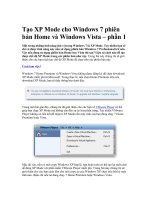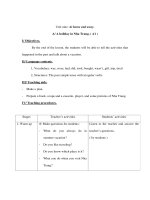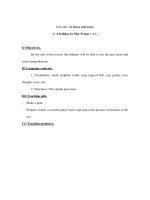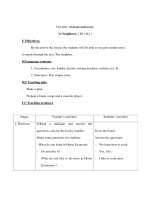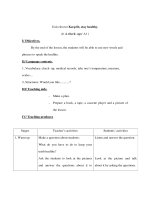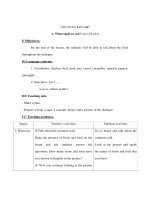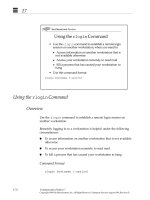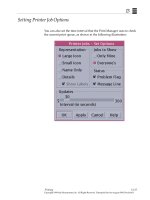Sun Fundamentals of Solaris 7 EU-118 Student Guide With Instructor Notes phần 1 ppt
Bạn đang xem bản rút gọn của tài liệu. Xem và tải ngay bản đầy đủ của tài liệu tại đây (300.34 KB, 53 trang )
Sun Microsystems, Inc.
500 Eldorado Blvd.
MS: BRM01-209
Broomfield, Colorado 80021
U.S.A.
®
FundamentalsofSolaris7
Revision D, August 1999
EU-118
StudentGuideWithInstructorNotes
Please
Recycle
Copyright 1999 Sun Microsystems, Inc. 901 San Antonio Road, Palo Alto, California 94303, U.S.A. All rights reserved.
This product or document is protected by copyright and distributed under licenses restricting its use, copying,
distribution, and decompilation. No part of this product or document may be reproduced in any form by any means
without prior written authorization of Sun and its licensors, if any.
Third-party software, including font technology, is copyrighted and licensed from Sun suppliers.
Parts of the product may be derived from Berkeley BSD systems, licensed from the University of California. UNIX is a
registered trademark in the U.S. and other countries, exclusively licensed through X/Open Company, Ltd.
Sun, Sun Microsystems, the Sun Logo, Solaris, AnswerBook, AnswerBook2, SunOS, ONC, OpenWindows, Java, NFS, and
HotJava are trademarks or registered trademarks of Sun Microsystems, Inc. in the U.S. and other countries.
All SPARC trademarks are used under license and are trademarks or registered trademarks of SPARC International, Inc.
in the U.S. and other countries. Products bearing SPARC trademarks are based upon an architecture developed by Sun
Microsystems, Inc.
PostScript is a trademark or registered trademark of Adobe Systems, Incorporated, which may be registered in certain
jurisdictions.
The OPEN LOOK and Sun Graphical User Interface was developed by Sun Microsystems, Inc. for its users and licensees.
Sun acknowledges the pioneering efforts of Xerox in researching and developing the concept of visual or graphical user
interfaces for the computer industry. Sun holds a non-exclusive license from Xerox to the Xerox Graphical User Interface,
which license also covers Sun’s licensees who implement OPEN LOOK GUIs and otherwise comply with Sun’s written
license agreements.
U.S. Government approval required when exporting the product.
RESTRICTED RIGHTS: Use, duplication, or disclosure by the U.S. Govt is subject to restrictions of FAR 52.227-14(g)
(2)(6/87) and FAR 52.227-19(6/87), or DFAR 252.227-7015 (b)(6/95) and DFAR 227.7202-3(a).
DOCUMENTATION IS PROVIDED "AS IS" AND ALL EXPRESS OR IMPLIED CONDITIONS, REPRESENTATIONS,
AND WARRANTIES, INCLUDING ANY IMPLIED WARRANTY OF MERCHANTABILITY, FITNESS FOR A
PARTICULAR PURPOSE OR NON-INFRINGEMENT, ARE DISCLAIMED, EXCEPT TO THE EXTENT THAT SUCH
DISCLAIMERS ARE HELD TO BE LEGALLY INVALID.
iii
Copyright 1999 Sun Microsystems, Inc. All Rights Reserved. Enterprise Services August 1999, Revision D
Contents
About This Course xvii
Course Overview xviii
Course Map xix
Module-by-Module Overview xx
Course Objectives xxvii
Skills Gained by Module xxviii
Topics Not Covered xxix
How Prepared Are You? xxx
Introductions xxxi
How to Use Course Materials xxxii
Course Icons and Typographical Conventions xxxiv
Icons xxxiv
Typographical Conventions xxxv
Notes to the Instructor xxxvi
Philosophy xxxvi
Course Tools xxxvii
Instructor Setup Notes xxxix
Purpose of This Guide xxxix
Course Files xl
Course Components xl
Solaris Computing Environment 1-1
Relevance 1-2
Introduction to Solaris 1-3
Main Components of a Computer 1-5
Random Access Memory (RAM) 1-7
Central Processing Unit (CPU) 1-7
Input/Output (I/O) 1-7
Hard Disk (or Other Forms of Mass Storage) 1-7
The Solaris Distributed Computing Solution 1-8
Kernel 1-10
Shell 1-12
The File System 1-14
Main Capabilities of the Operating System 1-17
iv Fundamentals of Solaris 7
Copyright 1999 Sun Microsystems, Inc. All Rights Reserved. Enterprise Services August 1999, Revision D
Main Capabilities of the Common Desktop Environment
(CDE) 1-18
Exercise: Using the Solaris Computing Environment 1-20
Tasks 1-20
Workshop Labs 1-21
Exercise Summary 1-22
Exercise Solutions 1-23
Check Your Progress 1-25
Think Beyond 1-26
Accessing Your System 2-1
Relevance 2-2
User Accounts 2-3
The Root Account 2-3
The /etc/passwd Entry 2-4
Password Requirements 2-6
The Mouse Buttons 2-7
The Left Mouse Button 2-7
The Middle Mouse Button 2-8
The Right Mouse Button 2-8
Logging In 2-9
The Options Button 2-10
Logging in Using the Login Screen 2-12
Logging in Using the Command Line 2-13
Exiting From the Command Line 2-14
Changing Your Password 2-15
The CDE Workspaces 2-17
Managing Windows 2-18
Overlapping Windows 2-18
Lowering a Window 2-19
Moving a Window 2-20
Minimizing a Window 2-22
Maximizing a Window 2-24
Closing a Window 2-26
Leaving the CDE Session 2-28
Using the Exit Button 2-28
Exercise: Accessing Your System 2-31
Tasks 2-31
Workshop Labs 2-32
Exercise Summary 2-33
Exercise Solutions 2-34
Check Your Progress 2-35
Think Beyond 2-36
Features of the Common Desktop Environment 3-1
Relevance 3-2
The Front Panel Arrangement 3-3
v
Copyright 1999 Sun Microsystems, Inc. All Rights Reserved. Enterprise Services August 1999, Revision D
Front Panel Menu Button 3-5
Locking the Display 3-7
Workspace Buttons 3-9
Minimizing the Front Panel 3-12
The Workspace Menu 3-14
Voice and Text Note Applications 3-16
Address Manager 3-18
Customizing Your Workspace With Style Manager 3-20
Style Manager Options 3-22
Color Control 3-22
Font 3-23
Backdrop 3-24
Keyboard 3-25
Mouse 3-26
Beep 3-27
Screen 3-28
Window 3-29
Startup 3-30
Notes 3-31
Customizing Subpanels 3-32
Application Manager 3-34
Exercise: Using the Front Panel 3-36
Tasks 3-36
Workshop Labs 3-37
Exercise Summary 3-38
Check Your Progress 3-39
Think Beyond 3-40
Getting Help 4-1
Relevance 4-2
Front Panel Help 4-3
Help Viewer 4-5
Searching the Help Index 4-6
AnswerBook2 4-7
On Item Help 4-9
Other Ways to Access Help 4-11
Displaying Man Pages 4-13
Using the man Command 4-13
Using the man Command Without Options 4-14
Scrolling in Man Pages 4-15
Searching Man Pages by Section 4-16
Exercise: Getting Help 4-18
Tasks 4-18
Workshop Labs 4-19
Exercise Summary 4-20
Exercise Solutions 4-21
vi Fundamentals of Solaris 7
Copyright 1999 Sun Microsystems, Inc. All Rights Reserved. Enterprise Services August 1999, Revision D
Check Your Progress 4-22
Think Beyond 4-23
Accessing Files and Directories 5-1
Relevance 5-2
File System Structure 5-3
Pathnames 5-4
Absolute Pathname 5-6
Relative Pathname 5-8
Command-Line Syntax 5-10
Changing Directories Using the cd Command 5-12
Command Format 5-12
Moving Around the Directory Hierarchy 5-13
Displaying the Current Directory Using the pwd Command 5-14
Command Format 5-14
Determining Your Current Directory 5-15
Using the ls Command 5-18
Command Format 5-18
Listing the Contents of a Directory 5-19
Displaying Hidden Files 5-19
Displaying File Types 5-20
Displaying a Long Listing 5-21
Listing Individual Directories 5-22
Metacharacters 5-23
Asterisk 5-24
Question Mark 5-26
Square Brackets 5-28
Semicolon 5-30
File System Structure 5-32
Exercise: Accessing Files and Directories 5-33
Tasks 5-33
Workshop Labs 5-36
Exercise Summary 5-37
Exercise Solutions 5-38
Check Your Progress 5-42
Think Beyond 5-43
Directory and File Commands 6-1
Relevance 6-2
Control Characters 6-3
Determining File Type 6-5
Command Format 6-6
Example Text File 6-6
Example Data File 6-7
Example Executable File 6-7
vii
Copyright 1999 Sun Microsystems, Inc. All Rights Reserved. Enterprise Services August 1999, Revision D
Displaying Files 6-8
Using the cat Command 6-8
Using the more Command 6-10
Using the head Command 6-12
Using the tail Command 6-14
Using the wc Command 6-16
Comparing Files 6-18
Locating Text Differences With the cmp Command 6-18
Using the diff Command 6-20
File and Directory Naming Conventions 6-23
Creating Files 6-25
Command Format 6-25
Creating Empty Files 6-25
Creating and Appending Using the tee Command 6-26
Creating Directories 6-28
Command Format 6-28
Creating Directories 6-29
Copying Files 6-31
Command Format 6-31
Copying a File to Another Within a Directory 6-32
Copying Multiple Files 6-32
Preventing Overwriting an Existing File When
Copying 6-32
Copying Directories 6-33
Command Format 6-33
Copying the Contents of a Directory to a New
Directory 6-34
Moving and Renaming Files 6-35
Command Format 6-35
Renaming Files in the Current Directory 6-36
Moving Files to Another Directory 6-36
Renaming Directories 6-37
Moving a Directory and Its Contents 6-37
Renaming in a Non-Current Directory 6-38
Removing Files 6-39
Command Format 6-39
Removing Directories 6-41
Command Format 6-41
Removing Directories 6-42
Redirection 6-43
Overview 6-43
Angle Brackets ( >, <, 2> ) 6-45
Angle Brackets ( >> ) 6-46
Piping 6-47
Displaying Command Output One Screen at a Time 6-48
Using the tee Command in a Pipeline 6-48
viii Fundamentals of Solaris 7
Copyright 1999 Sun Microsystems, Inc. All Rights Reserved. Enterprise Services August 1999, Revision D
Exercise: Using Directory and File Commands 6-49
Tasks 6-49
Workshop Labs 6-51
Exercise Summary 6-52
Exercise Solutions 6-53
Check Your Progress 6-56
Think Beyond 6-57
Managing Files With File Manager 7-1
Relevance 7-2
The File Manager 7-3
File and Folder Icons 7-5
Moving and Copying Files Using Drag-and-Drop 7-7
Select + Drag + Drop 7-8
Control + Select + Drag + Drop 7-8
File Menu Options 7-9
Creating a New Folder 7-10
Creating a New File 7-12
Folder or File Name Conflicts 7-13
Changing Folders 7-14
Finding Folders and Files 7-15
Selected Menu Options 7-17
View Menu Options 7-21
Tree Display for Folders 7-23
Exercise: Managing Files With File Manager 7-25
Tasks 7-25
Exercise Summary 7-26
Check Your Progress 7-27
Think Beyond 7-28
File Security 8-1
Relevance 8-2
Security Overview 8-3
Permissions 8-4
Superuser 8-4
The ls -l Command 8-5
Permission Categories 8-7
How File and Directory Access Is Determined 8-9
Process For Determining Permissions 8-10
Default Permissions 8-11
Types of Permissions 8-12
Changing Permissions 8-15
Overview 8-15
Symbolic Mode 8-16
Octal (Absolute) Mode 8-18
ix
Copyright 1999 Sun Microsystems, Inc. All Rights Reserved. Enterprise Services August 1999, Revision D
Default Permissions 8-22
The umask Filter 8-22
Changing the umask Value 8-26
Exercise: Changing File Permissions 8-27
Tasks 8-27
Workshop Labs 8-29
Exercise Summary 8-30
Exercise Solutions 8-31
Check Your Progress 8-34
Think Beyond 8-35
Using the vi Editor 9-1
Relevance 9-2
Introduction to vi 9-3
vi Modes 9-4
Invoking vi 9-6
Command Format 9-6
Input Commands 9-7
Positioning Commands 9-8
Editing Commands 9-9
Deleting Text 9-9
Undoing, Repeating, and Changing Text Commands 9-10
Copying and Pasting Text 9-11
Saving and Quitting Files 9-12
Advanced Editing Options 9-13
Creating and Saving a File 9-15
Exercise: Using the vi Editor 9-16
Tasks 9-16
Exercise Summary 9-17
Check Your Progress 9-18
Think Beyond 9-19
Bourne and Korn Shell Variables 10-1
Relevance 10-2
Introduction 10-3
Shell Variables 10-4
Overview 10-4
Local Shell Variables 10-6
Displaying Shell Variables 10-8
Environment Variables 10-9
Exporting Variables 10-10
Displaying Environment Variables 10-12
The PATH Variable 10-13
The which Command 10-14
The whereis Command 10-14
Exercise: Using Bourne and Korn Shell Variables 10-16
Tasks 10-16
x Fundamentals of Solaris 7
Copyright 1999 Sun Microsystems, Inc. All Rights Reserved. Enterprise Services August 1999, Revision D
Workshop Labs 10-17
Exercise Summary 10-18
Exercise Solutions 10-19
Check Your Progress 10-21
Think Beyond 10-22
Initialization Files 11-1
Relevance 11-2
Features of Initialization Files 11-3
Overview 11-3
The /etc/profile Script 11-5
Login Sequence 11-6
The .dtprofile 11-10
Shells 11-11
The ENV Environment Variable 11-14
Command Format 11-14
Setting the .kshrc Variable 11-14
Exercise: Setting Initialization Files 11-16
Tasks 11-16
Exercise Summary 11-17
Exercise Solutions 11-18
Check Your Progress 11-19
Think Beyond 11-20
Basic Features of the Korn Shell 12-1
Relevance 12-2
Korn Shell Overview 12-3
Quoting in Shells 12-4
Korn Shell Features 12-5
Custom Prompts 12-5
Aliases 12-7
History in the Korn Shell 12-10
Overview 12-10
The history Command 12-12
Re-Executing Commands 12-14
Editing the Command Line 12-16
Additional Features of the Korn Shell 12-18
Exercise: Using the Basic Features of the Korn Shell 12-19
Tasks 12-19
Workshop Labs 12-20
Exercise Summary 12-21
Exercise Solutions 12-22
Check Your Progress 12-24
Think Beyond 12-25
Printing 13-1
Relevance 13-2
xi
Copyright 1999 Sun Microsystems, Inc. All Rights Reserved. Enterprise Services August 1999, Revision D
Command Line Printing 13-3
Command Format 13-3
Sending Files to a Printer 13-4
Displaying Printer Status and Queues 13-5
Command Format 13-5
Displaying the Status of All of Your Output Requests 13-6
Displaying Requests on a Specific Printer’s Queue 13-6
Determining the Status of All Configured Printers 13-6
Determining Which Printers Are Configured on
Your System 13-7
Displaying Which Printers Are Accepting Requests 13-7
Removing a Print Request 13-8
Command Format 13-8
Canceling a Print Request 13-8
Printer Jobs 13-10
Viewing Printer Properties 13-12
Setting Printer Job Options 13-14
Printing From the File Manager 13-16
Displaying the Banner Page Title 13-18
Canceling a Print Request 13-19
Exercise: Printing Files 13-21
Tasks 13-21
Exercise Summary 13-22
Exercise Solutions 13-23
Check Your Progress 13-24
Think Beyond 13-25
File and User Information Utilities 14-1
Relevance 14-2
File Systems 14-3
Inode Numbers 14-5
Linking Files and Directories 14-6
Links 14-6
The ln Command 14-11
Finding Files 14-12
The find Command 14-12
Using the find Command 14-15
Additional Features of the find Command 14-16
The grep Command 14-17
Command Format 14-18
Switching to Another User Account Using the su
Command 14-19
Command Format 14-19
Using the su Command to Become Another User 14-20
xii Fundamentals of Solaris 7
Copyright 1999 Sun Microsystems, Inc. All Rights Reserved. Enterprise Services August 1999, Revision D
Using the id Command 14-21
Command Format 14-21
Displaying Your Current UID 14-22
Using the who Command 14-23
Command Format 14-23
Displaying Users on the System 14-23
Using the who am i and whoami Commands 14-25
who am i 14-25
whoami 14-26
The sort Command 14-27
Command Format 14-28
Using sort With Different Options 14-29
Using sort on Different Fields Within a File 14-30
Exercise: Using File and User Information Utilities 14-31
Tasks 14-31
Workshop Labs 14-33
Exercise Summary 14-34
Exercise Solutions 14-35
Check Your Progress 14-38
Think Beyond 14-39
Backing Up and Restoring 15-1
Relevance 15-2
Contents Overview 15-3
The tar Command 15-4
Command Format 15-4
Saving a Directory to Tape 15-5
The compress Command 15-6
Command Format 15-6
Command Format: Uncompressing 15-7
The jar Command 15-8
Command Format 15-8
Adding All the Files in a Directory to an Archive 15-9
The mt Command 15-10
Command Format 15-10
Commands 15-11
Backing up and Restoring the Home Directory 15-12
Backing up the Home Directory 15-12
Restoring the Home Directory 15-13
Exercise: Saving and Restoring Files 15-14
Tasks 15-14
Workshop Labs 15-14
Exercise Summary 15-15
Exercise Solutions 15-16
Check Your Progress 15-17
Think Beyond 15-18
xiii
Copyright 1999 Sun Microsystems, Inc. All Rights Reserved. Enterprise Services August 1999, Revision D
System Processes and Memory Management 16-1
Relevance 16-2
System Process Overview 16-3
Process Hierarchy 16-4
Processes and PIDs 16-6
Command Format 16-6
Displaying a Full Listing of All Processes 16-7
Searching for a Specific Process 16-8
Managing Jobs 16-9
Terminating Processes 16-13
Signals 16-13
The kill Command 16-14
Command Format 16-14
Terminating a Process 16-14
Memory 16-17
Physical Memory (RAM) and Swap Space 16-17
Paging 16-19
Exercise: Manipulating System Processes 16-20
Tasks 16-20
Workshop Labs 16-21
Exercise Summary 16-22
Exercise Solutions 16-23
Check Your Progress 16-25
Think Beyond 16-26
Network Basics 17-1
Relevance 17-2
Client-Server 17-3
Example Networking Environment 17-3
Distributed Processing 17-4
Network 17-4
Host 17-5
Server 17-5
Client 17-5
Naming Services 17-5
Network Commands 17-6
telnet 17-6
Using the rlogin Command 17-8
Overview 17-8
Specifying a Different Login ID 17-10
Logging in Remotely as Another User 17-11
Terminating a Local Process From a Remote
Machine 17-12
Using rlogin and pkill to Recover From a
“Hung” CDE Session 17-13
Using the ftp Command 17-14
xiv Fundamentals of Solaris 7
Copyright 1999 Sun Microsystems, Inc. All Rights Reserved. Enterprise Services August 1999, Revision D
Using the rusers Command 17-16
Command Format 17-16
Displaying Remote Users on a Network 17-16
The NIS+ Naming Service 17-18
Decentralized Administration 17-18
Centralized Administration 17-19
The NFS System 17-20
NFS Server 17-21
NFS Client 17-22
Exercise: Performing Network Basics 17-23
Tasks 17-23
Workshop Lab 17-23
Exercise Summary 17-24
Exercise Solutions 17-25
Check Your Progress 17-26
Think Beyond 17-27
Mail Tool and Calendar Manager 18-1
Relevance 18-2
The Mail Icon and Mail Window 18-3
The Mail Window 18-4
New Messages 18-5
Attached Files 18-5
Increasing and Decreasing the Message Viewing Area 18-6
Responding to a Received Message 18-7
Deleting Mail Messages 18-10
Creating Alternate Mailboxes 18-14
Moving Messages to Alternate Mailboxes 18-15
Composing New Mail Messages 18-16
Attaching Files to Mail Messages 18-17
Setting up Mail Aliases 18-18
Other Mail Tool Options 18-19
The Calendar Manager 18-20
Viewing the Calendar 18-22
Day View 18-22
Week View 18-23
Year View 18-24
Adding an Appointment 18-25
Setting Start and End Times 18-26
Selecting a Date 18-27
Appointment Editor Options 18-28
Printing Calendar Appointments 18-30
Setting Calendar Options 18-32
Editor Defaults 18-33
Display Settings 18-34
Access List and Permissions 18-35
xv
Copyright 1999 Sun Microsystems, Inc. All Rights Reserved. Enterprise Services August 1999, Revision D
Printer Settings 18-36
Date Format 18-37
Finding Appointments 18-38
Browsing Other Calendars 18-39
Exercise: Using the Mail Tool and Calendar Manager 18-40
Tasks 18-40
Exercise Summary 18-42
Check Your Progress 18-43
Think Beyond 18-44
Features of the C Shell A-1
C Shell Variables A-2
Local Variables A-2
Environment Variables A-3
Path A-4
History in the C Shell A-5
The history Command A-5
Command-Line Substitution A-7
C Shell Features A-12
Customizing Your Prompt A-12
Aliases A-13
Command-Line Mail B-1
Introduction to mailx B-2
Command-Line Mail B-3
Command Format B-3
Reading Your Mail B-3
Sending a Mail Message B-4
Canceling a Mail Message B-5
Reading a Mail Message B-6
Mail Headers B-7
Reading a Specific Message B-9
Deleting and Undeleting a Mail Message B-10
Replying to a Mail Message B-11
Saving a Mail Message B-13
Printing a Mail Message B-14
Command Format B-14
Sending a Message to the Printer B-14
Quitting Mail B-15
Sending a File Using Mail B-16
Creating a Mail Alias B-17
Command Format B-17
Using Tilde Commands B-18
Command Format B-18
Workshop Lab Solutions C-1
Module 2 – Accessing Your System C-3
xvi Fundamentals of Solaris 7
Copyright 1999 Sun Microsystems, Inc. All Rights Reserved. Enterprise Services August 1999, Revision D
Module 3 – Introduction to the Common Desktop
Environment C-4
Module 4 – Getting Help C-5
Module 5 – Accessing Files and Directories C-6
Module 6 – Directory and File Commands C-7
Module 8 – File Security C-8
Module 10 – Bourne and Korn Shell Variables C-9
Module 12 – Basic Features of the Korn Shell C-10
Module 14 – File and User Information Utilities C-11
Module 15 – Backing Up and Restoring C-12
Module 16 – System Processes and Memory Management C-13
Module 17 – Network Basics C-14
Metacharacters D-1
Introduction to sed and awk E-1
Regular Expressions E-2
Using Noninteractive Power Tools: sed E-3
Command Format E-3
Removing Characters With sed E-5
Placing Characters at the End of Each Line E-5
Changing White Space to Colons in Data E-6
Using Noninteractive Power Tools: awk E-7
Command Format E-7
Using awk to Display Specific Data E-8
The Text Editor F-1
Opening a Text Editor Window F-2
File Menu Options F-4
Edit Menu Options F-7
Replacing Text F-9
Format Menu Options F-12
Text Editor Options F-13
Index Index-1
xvii
Copyright 1999 Sun Microsystems, Inc. All Rights Reserved. Enterprise Services August 1999, Revision D
AboutThisCourse
Course Goal
This class is designed to introduce new users to UNIX
®
and the
Common Desktop Environment used with the Solaris™ 7 operating
system. Upon completion of this class, you will have an understanding
of basic UNIX commands and feel comfortable using the many
components of the windowing environment.
The concepts introduced in this class will prepare you for follow-on
courses pertinent to your job duties or career goals. These classes
include SA-237: Solaris 7 System Administration I, SL-120: Shell
Programming, and SL-125: Korn Shell Programming.
✓
Use this module to get the students excited about this course.
✓
With regard to the overheads: To avoid confusion among the students, it is very important
to tell them that the page numbers on the overheads have no relation to the page numbers
in their course materials. They should use the title of each overhead as a reference.
✓
The strategy provided by the “About This Course” is to introduce students to the course
before they introduce themselves to you and one another. By familiarizing them with the
content of the course first, their introductions will have more meaning in relation to the
course prerequisites and objectives.
✓
Use this introduction to the course to determine how well students are equipped with the
prerequisite knowledge and skills.
xviii Fundamentals of Solaris 7
Copyright 1999 Sun Microsystems, Inc. All Rights Reserved. Enterprise Services August 1999, Revision D
Course Overview
Attending this course provides hands-on experience with useful UNIX
commands. You will also learn to use and customize the features of the
Common Desktop Environment (CDE).
During the course of this class you will learn how to log in and out of
your workstation; gain an understanding of the file structure used in
Solaris 7 and ways in which to navigate this structure; protect your
files from unauthorized use; and create or remove directories and files.
A tutorial designed to introduce the basics of the standard UNIX
editor, vi, is included. Hands-on modules which will familiarize you
with the CDE graphical user interface (GUI) are an integral part of the
instruction. Throughout the course, emphasis is placed on preparing a
foundation of knowledge from which to build.
About This Course xix
Copyright 1999 Sun Microsystems, Inc. All Rights Reserved. Enterprise Services August 1999, Revision D
Course Map
A complete map of this course is shown below.
Solaris
Getting Started
Files and Directories
Managing Files and Processes
Computing Environment
Accessing Your
System
Features of the Common
Desktop Environment
Getting Help
Accessing Files
and Directories
Managing Files With
File Manager
File Security
Using the
Printing
vi Editor
Solaris Shells
File and User
Backing Up and
Restoring
Information Utilities
System Processes and
Memory Management
Bourne and Korn
Initialization Files
Basic Features of
the Korn Shell
Shell Variables
Networks Additional Programs
Network Basics
Mail Tool and
Calendar Manager
Directory and
File Commands
xx Fundamentals of Solaris 7
Copyright 1999 Sun Microsystems, Inc. All Rights Reserved. Enterprise Services August 1999, Revision D
Module-by-Module Overview
This course includes the following modules:
● Module 1 – “Solaris Computing Environment”
This module will introduce you to some basic computer concepts
and terminology. In particular, it focuses on the components and
capabilities of the UNIX operating system and the enhancements
of the Solaris computing environment (the Sun™ version of the
UNIX system).
● Module 2 – “Accessing Your System”
The purpose of a user password, the steps to log in and log out of
a computer, and how to change the user password, are described
in this module.
About This Course xxi
Copyright 1999 Sun Microsystems, Inc. All Rights Reserved. Enterprise Services August 1999, Revision D
Module-by-Module Overview
● Module 3 – “Features of the Common Desktop Environment”
Information on the ways in which the features of the CDE
graphical user interface, particularly the Front Panel, can be used
and modified to make your environment function appropriately
for you is provided in this module.
● Module 4 – “Getting Help”
This module describes how to access the information resources
available to you, including help for individual items and manual
pages.
● Module 5 – “Accessing Files and Directories”
This module will introduce you to the concepts concerning files
and directories, including using pathnames, locating and listing
them, and combining file and directory commands.
● Module 6 – “Directory and File Commands”
Solaris environment commands used to create and remove, find
information about, and perform other tasks on files and directories
are introduced in this module.
● Module 7 – “Managing Files With File Manager”
How to use the File Manager to organize and manage files is
described in this module.
xxii Fundamentals of Solaris 7
Copyright 1999 Sun Microsystems, Inc. All Rights Reserved. Enterprise Services August 1999, Revision D
Module-by-Module Overview
● Module 8 – “File Security”
This module describes the concepts and skills needed to use basic
security features.
● Module 9 – “Using the vi Editor”
How to use the vi editor to create and modify text files is
described in this module.
● Module 10 – “Bourne and Korn Shell Variables”
Setting and unsetting shell and environment variables, with a
focus on the Bourne and Korn shells, is covered in this module.
● Module 11 – “Initialization Files”
This module describes the files that the shell executes when you
log in to the system and gives an overview of the initialization files
for the Bourne, Korn, and C shells.
About This Course xxiii
Copyright 1999 Sun Microsystems, Inc. All Rights Reserved. Enterprise Services August 1999, Revision D
Module-by-Module Overview
● Module 12 – “Basic Features of the Korn Shell”
Additional information about the Korn shell and its features is
provided in this module.
● Module 13 – “Printing”
This module discusses the basic command-line commands that are
used to send a file to a printer, check the status of a printer queue,
and cancel a print request, respectively. The graphical interface of
the CDE Print Manager is also covered in detail in this module.
xxiv Fundamentals of Solaris 7
Copyright 1999 Sun Microsystems, Inc. All Rights Reserved. Enterprise Services August 1999, Revision D
Module-by-Module Overview
● Module 14 – “File and User Information Utilities”
This module introduces creating alternate names for files and
directories (linking), using commands to search for files when their
location is not known, and archiving files. This module also looks
at some commands that allow for more user functionality in a
multi-user environment, and tools that help users to manipulate
files and data.
● Module 15 – “Backing up and Restoring”
Basic UNIX utilities for backing up and restoring files are covered
in this module.
● Module 16 – “System Processes and Memory Management”
Some helpful commands for viewing and controlling the processes
running on the system are introduced in this module.
About This Course xxv
Copyright 1999 Sun Microsystems, Inc. All Rights Reserved. Enterprise Services August 1999, Revision D
Module-by-Module Overview
● Module 17 – “Network Basics”
Networking is an integral part of the Solaris 7 environment. This
module introduces some basic networking concepts and
commands.
● Module 18 – “Mail Tool and Calendar Manager”
The CDE Mail Tool provides a graphical interface for reading,
sending, and replying to electronic mail messages. This module
introduces ways in which the Mail Tool can be customized to meet
a user’s requirements. Calendar Manager provides a variety of
features, including scheduling and reminding you of
appointments, and viewing others’ calendars.
